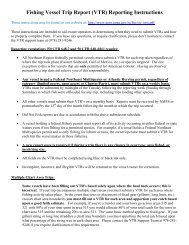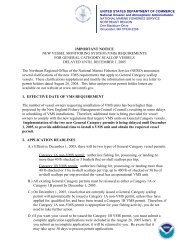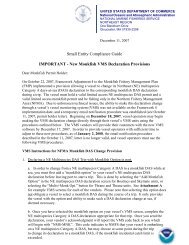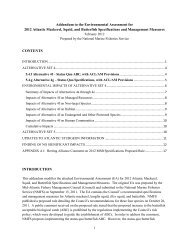modifications to the harbor porpoise take reduction plan - Northeast ...
modifications to the harbor porpoise take reduction plan - Northeast ...
modifications to the harbor porpoise take reduction plan - Northeast ...
You also want an ePaper? Increase the reach of your titles
YUMPU automatically turns print PDFs into web optimized ePapers that Google loves.
Observer data for gillnet hauls in <strong>the</strong> GOM between January 1, 1999 and May 31, 2007 are<br />
analyzed in Appendix D (Palka et al., 2008). In all management areas, <strong>harbor</strong> <strong>porpoise</strong> bycatch<br />
rates for hauls without pingers were greater than <strong>the</strong> bycatch rates of hauls with <strong>the</strong> required<br />
number of pingers, confirming <strong>the</strong> effectiveness of pingers as a <strong>harbor</strong> <strong>porpoise</strong> deterrent when<br />
properly deployed. The data indicate, however, that gillnet strings must have all of <strong>the</strong> required<br />
number of pingers and those pingers must be working properly <strong>to</strong> effectively reduce <strong>harbor</strong><br />
<strong>porpoise</strong> bycatch. On average, nets with only 80% of <strong>the</strong> required number of pingers had<br />
bycatch rates similar <strong>to</strong> nets with no pingers. Although <strong>the</strong> sample size is small, and <strong>the</strong><br />
operating conditions of <strong>the</strong> pingers are unknown, <strong>the</strong> data suggest that nets with fewer than <strong>the</strong><br />
required number of pingers had bycatch rates that were higher than nets with no pingers at all. A<br />
possible ex<strong>plan</strong>ation is that <strong>harbor</strong> <strong>porpoise</strong>s may correlate a gap in pingers with a gap in <strong>the</strong> net<br />
and try <strong>to</strong> swim through <strong>the</strong> portion of <strong>the</strong> net string that does not contain pingers. While <strong>the</strong><br />
present data are insufficient <strong>to</strong> examine this more closely, NMFS observers are collecting more<br />
detailed information on <strong>the</strong> functionality of <strong>the</strong> pingers on nets surrounding a <strong>harbor</strong> <strong>porpoise</strong><br />
<strong>take</strong>. In summary, <strong>the</strong>se findings confirm <strong>the</strong> need for regulations that compel fishermen <strong>to</strong><br />
properly install and maintain all necessary pingers, as well as <strong>the</strong> need for NMFS and <strong>the</strong> New<br />
England states <strong>to</strong> continue outreach and enforcement efforts.<br />
Mid-Atlantic<br />
Assessment of <strong>the</strong> effectiveness of <strong>the</strong> individual gear modification requirements of <strong>the</strong> HPTRP<br />
in <strong>the</strong> Mid-Atlantic is difficult, since many of <strong>the</strong> fac<strong>to</strong>rs are interrelated. Palka et al. (2009)<br />
analyzed observer data from <strong>the</strong> Mid-Atlantic gillnet fisheries between January 1, 1999 and May<br />
31, 2007 (Appendix A) and identified a number of gear variables that appear <strong>to</strong> relate <strong>to</strong> a high<br />
bycatch rate. However, many of <strong>the</strong>se variables occur in <strong>the</strong> same nets. For example, large<br />
mesh size, use of tie-downs, use of more anchors, and long soak times all occur in nets targeting<br />
monkfish. In addition <strong>to</strong> <strong>the</strong>se variables, net string length appears <strong>to</strong> relate <strong>to</strong> higher bycatch<br />
rates in large mesh nets. Bycatch in large mesh hauled nets with string lengths greater than<br />
4,000 ft (1,219 m) was three times higher than bycatch rates in hauled nets with string lengths<br />
less than 4,000 ft (1,219 m). Currently, large mesh gillnet fishermen fishing between January 1<br />
and April 30 (except during closure periods) in <strong>the</strong> Waters off New Jersey Management Area are<br />
required <strong>to</strong> use nets strings that are no longer than 4,800 ft (1,463 m) in length, and strings no<br />
longer than 3,900 ft (1,189 m) are allowed in <strong>the</strong> Mudhole Management Area during this period.<br />
String length was <strong>the</strong> most common non-compliant fac<strong>to</strong>r identified in hauls observed in <strong>the</strong><br />
Waters off New Jersey, where 28 (65%) of 43 observed <strong>harbor</strong> <strong>porpoise</strong> <strong>take</strong>s were in noncompliant<br />
gear, and 60% of all hauls observed were non-compliant.<br />
Observer data displayed in Figures 3.2 and 3.3 in Appendix A (Palka et al., 2009) show a large<br />
number of <strong>take</strong>s just south and east of <strong>the</strong> current Mudhole Management Area, outside <strong>the</strong> area<br />
in which more restrictive gear <strong>modifications</strong> and closures are required. The bycatch analysis<br />
identifies a strong relationship between a higher than average bycatch rate in <strong>the</strong> Waters off New<br />
Jersey, including <strong>the</strong> Mudhole, and <strong>the</strong> water temperature of <strong>the</strong> observed haul (waters less than<br />
43° F, ~6° C), water depths (164- 361 ft, 50 – 110 m), large mesh size, and location of <strong>the</strong><br />
observed haul. This analysis supports <strong>the</strong> seasonal requirements and location of <strong>the</strong> existing<br />
Mudhole Management Area. However, it also identifies an area of high bycatch rates south and<br />
east of <strong>the</strong> Mudhole Management Area that merits consideration for fur<strong>the</strong>r restrictions.<br />
14











